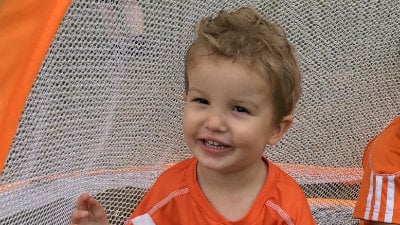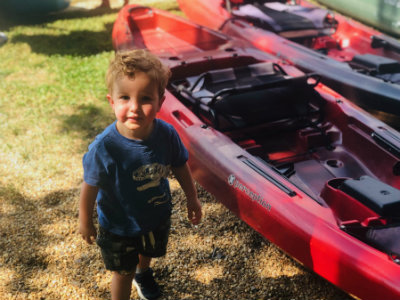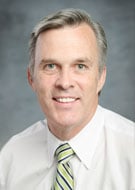
Thomas's Story

Newborn Thomas’s first weeks of life were a true whirlwind. Within hours of his early birth, he was whisked from the birth hospital to nearby Children’s National Hospital, home to the nation’s number one NICU.
Thomas’s internal and external challenges, all considered individually very rare, added up to an extremely rare combination known as VACTERL association, which includes at least three of the following occurring together: vertebral defects, anal atresia, cardiac defects, trachea-esophageal fistula, renal anomalies and limb abnormalities. Thomas had four of these together.
Doctors estimate this occurs only once in every 10,000 – 40,000 births each year. The most urgent challenges were found in his digestive system: His intestine, trachea and esophagus were all misaligned, meaning he couldn’t have a normal bowel movement and he couldn’t feed normally either.
“I remember the team at Children’s calling us as we were driving over to Children’s. Thomas needed surgery and they needed our consent right then,” recalls Suzanne. ”When we did get there, they sat us down and they drew a lot of diagrams to explain to us what was going on. One thing was clear though--it was going to be a long time before our son went home with us.”
In total, Thomas would require three major surgeries to correct his duodenal atresia, trachea-esophageal fistula, esophageal atresia and finally one for his hand, too.
Prescription: Wait
One of these crucial surgeries couldn’t be done right away, however, according to Mikael Petrosyan, M.D., who led much of Thomas’s surgical care. Rather than perform an invasive and potentially complicated procedure to connect Thomas’s stomach to his esophagus immediately to resolve the esophageal atresia, he recommended they give Thomas some time to grow.
If Thomas’s esophagus became long enough on its own, the easier reconnection would mean less rehabilitation and faster recovery. The downside was that Thomas would have to stay in the NICU to be monitored and stay healthy until surgery.
As hard as it was to wait, the Derrs decided to trust his advice, especially after Jason googled the surgical options and found that their own “Dr. P.” was the author of several research articles on this very subject.
His expertise was spot-on. After nearly four months in the NICU, Dr. Petrosyan was thrilled to tell the Derrs that Thomas’s esophagus had grown exactly as he’d hoped, and that the reconnection would be as simple as possible.
The Derrs are extremely grateful for Dr. Petrosyan’s expertise and Thomas recovered well from the surgery. Over the course of the next year, Thomas had many hospital visits and additional procedures, including a reconstructive surgery with Gary Rogers, M.D., chief of plastic and reconstructive surgery, to “build” Thomas a new a fully functioning thumb by “borrowing” from one of his existing digits.
Surgeon “On Call”
Through it all, Dr. Petrosyan kept in touch personally, reassuring their worries and facilitating check in appointments and procedures when needed. But most important, his calm, friendly expertise helped them feel confident as they transitioned Thomas back to normal life as a toddler.

On their first family vacation, for example, when Thomas had trouble swallowing some food, Dr. Petrosyan talked them through it. He helped them find a healthcare facility close to their vacation home and planned to call the care team there to talk them through Thomas’s history and needs.
Thankfully, it wasn’t needed—with Dr. Petrosyan “on call” to reassure them, they were able to give Thomas some time to work out the issue on his own. And he did.
Dr. “T” and Chocolate Cake
Thomas and his family spent so much time with Dr. Petrosyan in those early years that for his second Halloween, Thomas dressed up as “Dr. T.” in honor of his favorite “Dr. P.”
With his surgeries behind him, the little boy who couldn’t swallow anything for his first four months of life now LOVES to eat, and chocolate cake is his favorite. He’s a happy, healthy three-year-old and a proud big brother.
“One of my coworkers gave me the best advice, and I want to pass it on,” says Suzanne. “Even on the darkest days you have to trust in the process and that the doctors know what they are doing. Turn over your trust to the medical team. Thanks to Dr. P. and the team at Children’s National, we felt very comfortable doing that. And it turned out for the best.”

